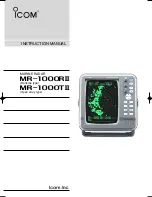
22. Maintenance and Troubleshooting
22-2
22.1 Maintenance
Regular maintenance is essential to good performance. A regular maintenance program should be established and
should at least include the items shown in the table below.
Maintenance schedule
Interval
Check point
Check and measures
Remarks
FURUNO-
supplied LCD
monitor and
processor units
Dust and dirt may be removed
from these units with a soft
cloth.
The LCD will in time
accumulate a layer of dust
which can dim the picture.
Wipe the LCD carefully to
prevent scratching, using
tissue paper and an LCD
cleaner. To remove stubborn
dirt, use an LCD cleaner,
wiping slowly with tissue
paper so as to dissolve the
dirt. Change paper frequently
so the dirt will not scratch the
LCD.
Do not use chemical-based cleaners
for cleaning. They can remove paint
and markings.
When needed
Filter on processor
units
Clean the filter at the rear of
the processor units if it is
dusty.
Once every 3
to 6 months
Cabling
Check that all cabling is
firmly connected and is not
damaged.
Exposed bolts and
nuts of antenna
unit
Exposed bolts and nuts are
subject to corrosion. Further,
they may loosen by vibration.
Check that bolts and nuts are securely
fastened. Refasten if necessary. If
corroded, clean and coat with
anticorrosive sealant.
Radiator
Dust, dirt and salt deposits on
the radiator cause signal
attenuation, resulting in loss
of sensitivity. Wipe radiator
with a freshwater-moistened
cloth.
The radiator is made of fibreglass
reinforced plastic. Therefore, do not
used gasoline, benzene and the like to
clean the radiator.
If the radiator is iced, use a wooden or
plastic headed hammer to remove the
ice. DO NOT use a steel hammer.
Every 3 to 6
months
Terminals,
connectors
Check that all terminals and
connectors on circuit boards
are securely fastened.
Have a qualified technician check
terminals and connectors.
6 months to 1
year
Screws on
terminal boards in
processor units
Check that all screws are
tightly fastened.
Have a qualified technician check
screws.
Summary of Contents for FCR-2107 series
Page 42: ...1 Operational Overview 1 20 This page intentionally left blank...
Page 154: ...5 AIS Operation 5 28 This page intentionally left blank...
Page 255: ...7 Vector Chart Material 7 83 Recommended track defined by two beacons...
Page 256: ...7 Vector Chart Material 7 84 Recommended track defined by a building and a beacon...
Page 257: ...7 Vector Chart Material 7 85 Measurement mile tails tails...
Page 298: ...9 Chart Alerts 9 14 This page intentionally left blank...
Page 322: ...10 Route Planning 10 24 This page intentionally left blank...
Page 368: ...14 Backup Operations 14 6 This page intentionally left blank...
Page 404: ...16 Recording Functions 16 16 This page intentionally left blank...
Page 406: ...17 NAVTEX Messages 17 2 This page intentionally left blank...
Page 416: ...19 Parameters Setup 19 8 This page intentionally left blank...
Page 457: ...Appendix 2 IHO ECDIS Chart 1 AP 5 Nature and Man made features Port features...
Page 458: ...Appendix 2 IHO ECDIS Chart 1 AP 6 Depths Currents etc Seabed Obstructions Pipelines etc...
Page 459: ...Appendix 2 IHO ECDIS Chart 1 AP 7 Traffic routes Special areas...
Page 460: ...Appendix 2 IHO ECDIS Chart 1 AP 8 Aids and Services Buoys and Beacons...
Page 461: ...Appendix 2 IHO ECDIS Chart 1 AP 9 Topmarks Color test diagram...
Page 462: ...Appendix 2 IHO ECDIS Chart 1 AP 10 Mariners navigational symbols...
Page 469: ...Appendix 3 Interpreting S57 Charts AP 17 Fog signals Radars Services...
Page 476: ...Appendix 3 Interpreting S57 Charts AP 24 This page intentionally left blank...
Page 511: ...Appendix 5 Digital Interface AP 59 NRX NAVTEX received data...
Page 544: ...Appendix 6 Parts List and Parts Location AP 92 This page intentionally left blank...
Page 550: ...This page is intentionally left blank...
Page 556: ......
















































